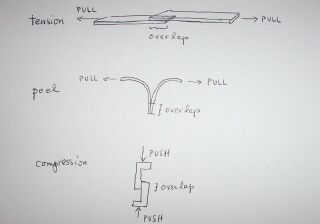|
First
Lab Task
Samples
are given a code identification, written on the sample with
waterproof ink.
example:
010913FWC-SS
code
meaning:
- prep.
date '01 = year
- 09
= month
- 13
= day
- FW
= Fastweld epoxy
- C
= air cure control sample
- SS
= stainless steel
epoxy
codes
- FW
= Fastweld
- 88
= Epoxo88
- 911
= Bio-Fix 911
- 3070
= Epoxy 10-3070
- FS
= FastSteel
- RIQ
= Repairitquik
cure
condition codes
- C
= air cure control sample
- REF
= refrigerated sea water
- SEA
= outdoors sea water
material
- OW
= oak wood
- SS
= stainless steel (non-magnetic)
- CS
= carbon steel (magnetic)
- AH
= heavy aluminum sheet
- AL
= light aluminum sheet
There
are three types of tests that will be performed by Prof. Ucci's
students: tension, peel, and compression. Tension tests will
be done on SS, CS, AH. Compression test will be done on OW.
Peel test will be done on AL.

Wash and scrub the metal samples to remove grease and dirt.
Use Scotch-BriteTM soap pads. Dry metal samples
carefully with paper towels and touch them only with gloved
hands.
Make a sketch of each sample, as you intend to lay it out
and epoxy it. Measure and mark the overlap area with pencil
on the metal. Make a square overlap area. If the sample is
2" wide, the overlap will be 2"X2"; if the sample is 1.5"
wide, the overlap will be 1.5"X1.5". The epoxy has a "pot
life" of only a few minutes. Mix up only as much epoxy at
one time as you can use in 5 minutes. |

